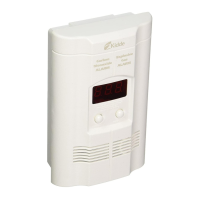See “What to do When the Alarm Sounds” (inside front cover).
High Levels:
Generally above 100 PPM, with no one experiencing symptoms. This
should be treated as an urgent situation. See “What to do When the
Alarm Sounds” (inside front cover).
Mid Levels:
Generally between 50 PPM to 100 PPM. This should be cause for
concern and should not be ignored or dismissed. See “What to do
When the Alarm Sounds” (inside front cover).
Low Levels:
Generally below 50 PPM. Kidde recommends you take action to
eliminate the source of CO. See “What to do When the Alarm Sounds”
(inside front cover).
Possible Sources of Carbon Monoxide
Inside your home, appliances used for heating and cooking are the most
likely sources of CO. Vehicles running in attached garages can also
produce dangerous levels of CO.
CO can be produced when burning any fossil fuel, such as gasoline,
propane, natural gas, oil and wood. It can be produced by any fuel-
burning appliance that is malfunctioning, improperly installed, or not
ventilated correctly, such as:
• Automobiles, furnaces, gas ranges/stoves, gas clothes dryers, water
heaters, portable fuel burning space heaters and generators,
fireplaces, wood-burning stoves and certain swimming pool heaters.
• Blocked chimneys or flues, back drafts and changes in air pressure,
corroded or disconnected vent pipes, loose or cracked furnace
exchangers.
• Vehicles and other combustion engines running in an open or closed
garage, attached or near a home.
• Burning charcoal or fuel in grills and hibachis in an enclosed area.
Conditions That Can Produce Carbon Monoxide
The following conditions can result in transient CO situations:
• Excessive spillage or reverse venting of fuel-burning appliances caused
by outdoor ambient conditions, such as, wind direction and/or veloci-
ty, including high gusts of wind, heavy air in the vent pipes
(cold/humid air with extended periods between cycles).
1. Information About Carbon Monoxide
and Explosive Gas

